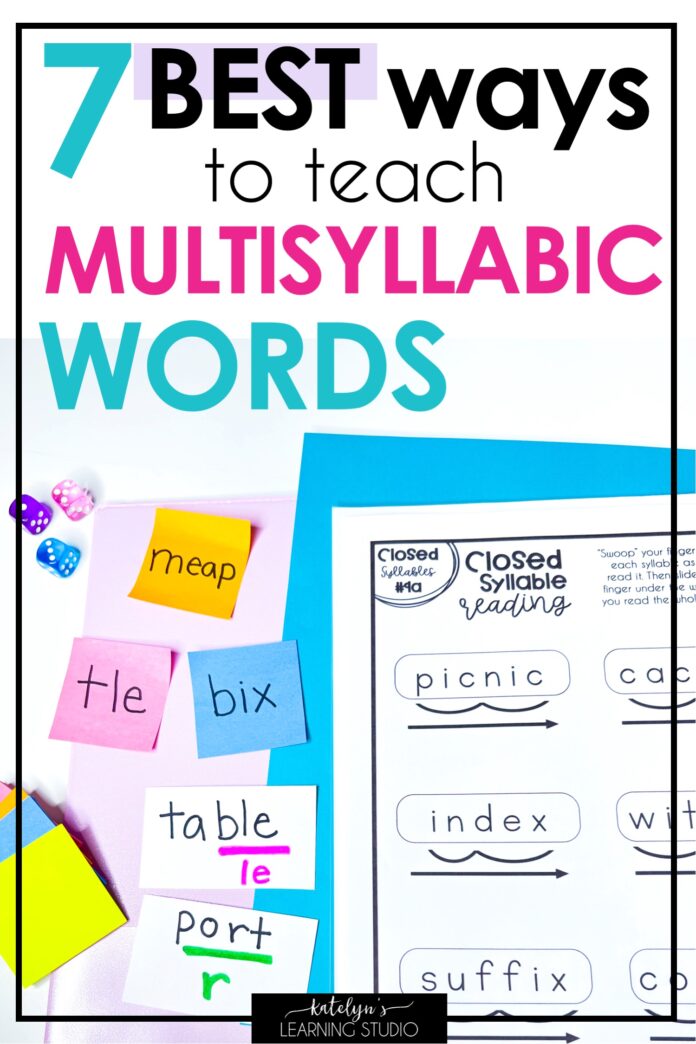
Building Confidence: Strategies for Teaching Multisyllabic Words to Struggling Readers
For struggling readers, tackling multisyllabic words can often be a daunting and overwhelming task. However, with the right strategies and approaches, educators can help build confidence and empower these students to tackle these challenging words with ease. In this article, we will explore some effective strategies for teaching multisyllabic words to struggling readers, with a focus on building confidence and fostering a positive learning environment.
Understanding the Challenge
Before delving into specific strategies, it’s important to understand the challenges that struggling readers face when it comes to multisyllabic words. For many of these students, decoding longer words can be overwhelming, leading to frustration and a lack of confidence in their reading abilities. Additionally, these words often contain prefixes, suffixes, and root words, making them even more complex to decode and understand.
As educators, it’s important to recognize that struggling readers may have limited phonemic awareness and may struggle with decoding and recognizing patterns in longer words. This is why it’s crucial to approach the teaching of multisyllabic words with patience, empathy, and effective strategies that cater to the specific needs of these students.
Utilizing Word Parts
One effective strategy for teaching multisyllabic words to struggling readers is to focus on word parts, such as prefixes, suffixes, and root words. By breaking down longer words into smaller, more manageable parts, students can better understand the structure and meaning of the word. For example, by teaching students common prefixes and suffixes, they can learn to recognize these word parts and apply them to other words they encounter.
Additionally, teaching students about root words and how they combine with prefixes and suffixes to form multisyllabic words can help build their word recognition skills and improve their overall reading comprehension. By providing students with a strong foundation in word parts, educators can empower them to decode and understand a wide range of multisyllabic words with confidence.
Scaffolded Instruction
Scaffolded instruction is another effective approach for teaching multisyllabic words to struggling readers. This involves breaking down the learning process into smaller, more manageable steps, providing students with the support and guidance they need to successfully tackle longer words. This may include using visual aids, mnemonic devices, and other tools to help students remember and apply the strategies they’ve learned.
Additionally, educators can provide students with ample opportunities to practice decoding multisyllabic words in a supportive and encouraging environment. By gradually increasing the complexity of the words and providing students with the necessary support and feedback, educators can help build their confidence and competence in tackling these challenging words.
Explicit Instruction
Providing explicit instruction is crucial for teaching multisyllabic words to struggling readers. This involves clearly and directly teaching students the specific strategies and skills they need to decode and understand longer words. By guiding students through the process of breaking down words, identifying word parts, and applying their knowledge, educators can help students develop a deeper understanding of how words are structured and how they can be decoded.
In addition to explicit instruction, it’s important to provide students with ample opportunities for guided practice and feedback. By engaging students in interactive and meaningful activities that focus on multisyllabic words, educators can help reinforce their learning and build their confidence in tackling these words independently.
Vocabulary Development
Building students’ vocabulary is an essential component of teaching multisyllabic words. By incorporating vocabulary development activities into the teaching of longer words, educators can help students expand their word knowledge and improve their reading comprehension. This may involve introducing students to context clues, word roots, and word meanings to help them understand the nuances of multisyllabic words.
Moreover, educators can create a print-rich environment that exposes students to a wide range of words, both in and out of the classroom. By immersing students in language-rich experiences, educators can help foster a love for words and language while simultaneously building their confidence in tackling multisyllabic words.
Differentiated Instruction
It’s important to recognize that every student has unique learning needs and abilities. Therefore, utilizing differentiated instruction is essential when teaching multisyllabic words to struggling readers. This may involve tailoring instruction to meet the specific needs of each student, providing additional support and resources as needed, and offering alternative strategies to accommodate different learning styles.
By differentiating instruction, educators can create a personalized learning experience for struggling readers, allowing them to progress at their own pace and build their confidence in tackling multisyllabic words. This approach not only addresses the individual needs of students but also empowers them to take ownership of their learning and develop a positive attitude towards reading and language.
Promoting a Growth Mindset
Finally, promoting a growth mindset is crucial for helping struggling readers tackle multisyllabic words with confidence and determination. By emphasizing the importance of effort, perseverance, and resilience, educators can inspire students to approach challenges with a positive and open mindset. This involves praising students for their hard work, encouraging them to persist through difficulties, and fostering a supportive and nurturing learning environment.
Additionally, educators can model a growth mindset by demonstrating their own willingness to learn and grow, emphasizing the value of making mistakes, and celebrating the progress and achievements of their students. By instilling a growth mindset in struggling readers, educators can help build their confidence and motivation to tackle multisyllabic words and develop a lifelong love for reading and learning.
In conclusion, teaching multisyllabic words to struggling readers requires patience, empathy, and effective strategies that cater to their specific needs. By utilizing word parts, scaffolded instruction, explicit instruction, vocabulary development, differentiated instruction, and promoting a growth mindset, educators can empower struggling readers to tackle these challenging words with confidence and determination. With the right support and guidance, students can develop the skills and knowledge they need to become proficient readers and lifelong learners.


















